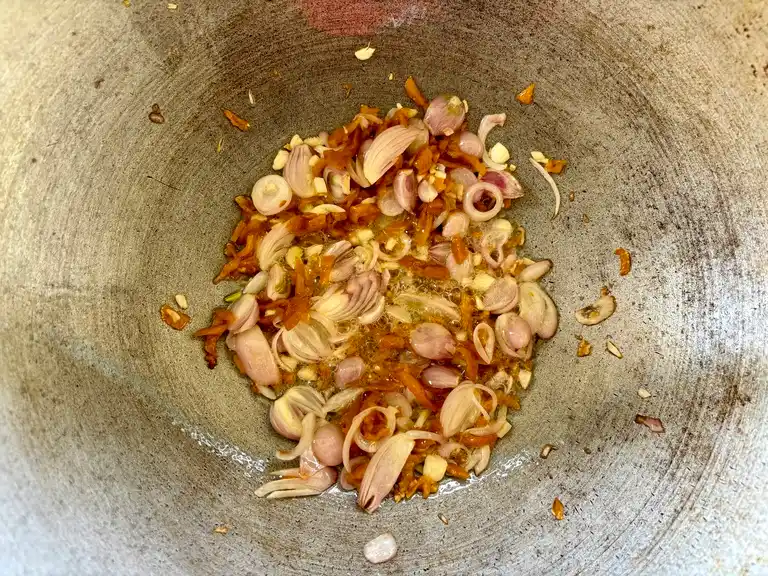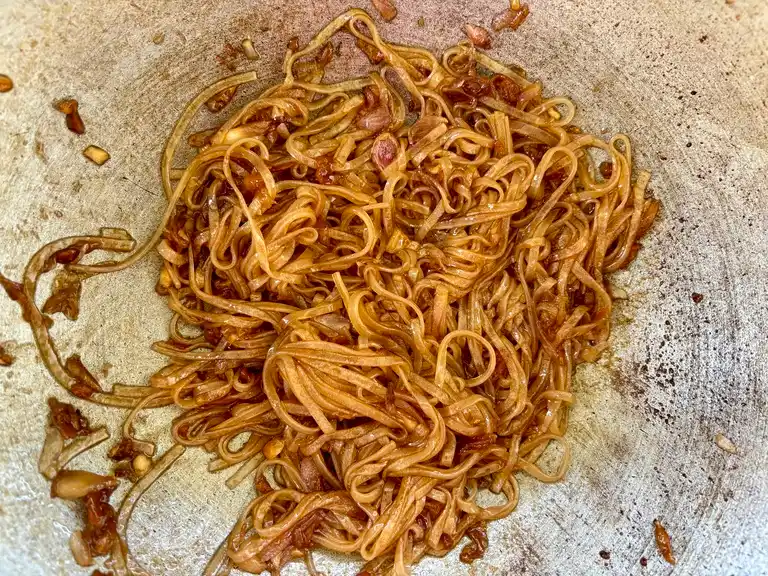Vegetarian Pad Thai Vegetables
As an Amazon Associate, I earn from qualifying purchases. Read the full disclosure here .
This vegetarian pad Thai vegetables recipe comes together in just 20 minutes and tastes way better than takeout. Enjoy easy, healthy vegan noodles that are perfect for a quick family dinner on a busy weeknight.

Note: Want to add protein? Try my authentic chicken or beef versions, both of which use my mother’s homemade pad Thai sauce!
Vegetable pad thai is a Thai stir-fried noodle dish made with rice noodles, vegetables, and sometimes tofu or egg, tossed in a tangy-sweet sauce. It’s flavored with tamarind, soy sauce, and palm sugar, then topped with peanuts. The flavor is savory, slightly sweet, and tangy.
My favorite vegetarian Thai noodles
This recipe stays true to the authentic flavor I learned to make while working at Thai restaurants. The only difference is swapping fish sauce for light soy sauce to keep it vegan-friendly, but the taste is just as good.
Some Western versions add peanut butter or ketchup, but that’s not how we make it in Thailand. For the best results, just use the traditional ingredients, and you’ll get way better flavor.

The best vegetables for pad Thai are ones that stay crisp and hold their shape when stir-fried. I love using bean sprouts, garlic chives, and julienned carrots. You can also toss in bell peppers, snap peas, baby corn, shredded cabbage, or broccoli if that’s what you have on hand.
Ingredient notes
You can find everything you need at Asian markets or Asian grocery stores. Head to the recipe card at the bottom of this post for all the measurements!

- Noodles – The classic pad Thai noodles are rice noodles. You can find these at any Asian supermarket, available in thin and thick varieties.
- Tamarind paste, palm sugar, light soy sauce, water – These are the ingredients for our homemade vegetarian pad Thai sauce.
- Sweet preserved radish – Adds a unique, slightly sweet and salty crunch to the dish, giving it extra flavor.
- Shallots
- Garlic
- Bean sprouts
- Garlic chives
- Carrots
- Oil – Use a neutral oil with a high smoke point, like canola or vegetable oil.
- Roasted peanuts (optional) – For garnish.
How to make vegetarian pad Thai
Step 1: Soak and drain dry rice noodles according to package labeling.

Step 2: Heat oil in a wok over medium heat. Sauté shallots, garlic, and sweet preserved radish until fragrant, about a minute.

Step 3: Stir in the palm sugar until it’s fully dissolved and starts to caramelize.

Step 4: Add your stir-fry sauces; tamarind paste, light soy sauce, and water. Mix well before continuing.

Step 5: Add your pre-soaked rice noodles and stir-fry them until they’re soft yet chewy and well-coated with the sauce.

Step 6: Add carrots and cook until they’re softened to your liking. Then, turn off the heat and gently stir in the bean sprouts and garlic chives to retain their crunch. Serve immediately, optionally garnished with chili flakes, peanuts, and a lime wedge.

Recipe tips and tricks
Here are my best tips for making this vegetable pad Thai!
- Cook over medium-high heat: Stir-frying is best done over medium-high heat, so your ingredients cook quickly and develop that signature charred flavor.
- Chewy vs soft noodles: This recipe soaks the rice noodles in water for a chewy bite. If you want soft noodles, soak them first and then give them a quick blanch in boiling water before tossing them into the wok.
- Fresh vegetables: Opt for fresh veggies whenever possible. Quickly stir-fry them until they’re just tender but still have a bit of crunch.
- Prep in advance: Make sure you have all your vegetables chopped and ready before you start cooking.
More vegetarian Thai recipes to try
Loved reading this vegetarian pad Thai vegetables recipe? Please make my day by dropping a star rating and/or a comment below! Follow me on Facebook, Instagram, and Pinterest.
Vegetarian Pad Thai Vegetables

Equipment
- Cutting board and sharp knife
- Wok or large nonstick skillet
- Tongs or spatula
Ingredients
- 5 oz dry rice noodles
- 2 tbsp oil
- 1/3 cup shallots, sliced
- 2 cloves garlic
- 3 tbsp sweet preserved radish
- 4 tbsp palm sugar
- 2 tbsp tamarind paste
- 6 tbsp water
- 3 tbsp light soy sauce
- 1/2 cup bean sprouts
- 6 stalks garlic chives, cut into 1-inch pieces
- 1/2 cup carrots, thinly sliced
- 2 tbsp roasted peanuts, add to taste
Instructions
- Soak and drain the dry rice noodles according to the package instructions.
- Heat oil in a wok over medium heat. Sauté the shallots, garlic, and sweet preserved radish until fragrant, about 1 minute.
- Add the palm sugar and stir until fully dissolved and starting to caramelize.
- Pour in your stir-fry sauces: tamarind paste, light soy sauce, and water. Stir well to combine.
- Add the soaked rice noodles and stir-fry until they’re soft but still chewy, and evenly coated in the sauce.
- Toss in the carrots and cook until they’re tender to your liking. Turn off the heat, then gently stir in the bean sprouts and garlic chives so they stay crisp. Serve immediately and garnish with optional peanuts, chili flakes, and lime. Enjoy!
Notes
- Use the nutrition card in this recipe as a guideline.
- Feel free to customize this recipe with your favorite vegetables.






